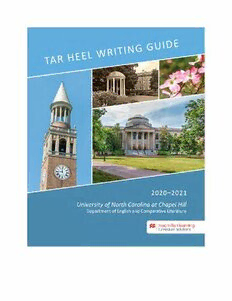
Tar Heel Writing Guide PDF
Preview Tar Heel Writing Guide
Tar Heel Writing Guide 2020–2021 University of North Carolina at Chapel Hill Department of English and Comparative Literature Copyright © 2021 by the Department of English and Comparative Literature, University of North Carolina at Chapel Hill Copyright © 2021 by Hayden-McNeil, LLC on illustrations provided Photos provided by Hayden-McNeil, LLC are owned or used under license Cover Images: wayfarerlife/Shutterstock.com; Sara Kendall/Shutterstock.com; Bryan Pollard/Shutterstock.com; KPG Payless2/Shutterstock.com; All rights reserved. Permission in writing must be obtained from the publisher before any part of this work may be reproduced or transmitted in any form or by any means, electronic or mechanical, including photocopying and recording, or by any information storage or retrieval system. ISBN 978 1 53392820 7 (ePub) Macmillan Learning Curriculum Solutions 14903 Pilot Drive Plymouth, MI 48170 www.macmillanlearning.com Jack-Larson 2820-7 F20 Sustainability Hayden-McNeil/Macmillan Learning Curriculum Solutions is proud to be a part of the larger sustainability initiative of Macmillan, our parent company. Macmillan has a goal to reduce its carbon emissions by 65% by 2020 from our 2010 baseline. Additionally, paper purchased must adhere to the Macmillan USA Paper Sourcing and Use Policy. Hayden-McNeil partners with printers that use paper that is consistent with the environmental goals and values of Macmillan USA. This includes using paper certified by the Forest Stewardship Council (FSC), Sustainable Forestry Initiative (SFI), and/or the Programme for the Endorsement of Forest Certification (PEFC). We also offer paper with varying percentages of post-consumer waste as well as a 100% recycled stock. Additionally, Hayden-McNeil Custom Digital provides authors with the opportunity to convert print products to a digital format to use no paper at all. Visit http://sustainability.macmillan.com to learn more. Table of Contents Introduction Part 1: Writing in the Disciplines 1-1: Writing in the Natural Sciences Outcome 1: Explaining How the Natural Sciences Work Outcome 2: Locating and Evaluating Evidence in the Natural Sciences Outcome 3: Reading Strategically in the Natural Sciences Outcome 4: Writing in the Natural Sciences 1-2: Writing in the Social Sciences Outcome 1: Explaining How the Social Sciences Work Outcome 2: Locating and Evaluating Evidence in the Social Sciences Outcome 3: Reading Strategically in the Social Sciences Outcome 4: Writing in the Social Sciences 1-3: Writing in the Humanities Outcome 1: Explaining How the Humanities Work Outcome 3: Reading Strategically in the Humanities Outcome 4: Writing in the Humanities 1-4: Writing in Business Outcome 1: Explaining How Business Communication Works Outcome 2: Locating and Evaluating Evidence in Business Communication Outcome 3: Reading Strategically in Business Communication Outcome 4: Writing in Business 1-5: Writing in Law Outcome 1: Explaining How Legal Communication Works Outcome 2: Locating and Evaluating Evidence in Legal Communication Outcome 3: Reading Legal Communication Strategically Outcome 4: Writing in Law 1-6: Writing in Health & Medicine Outcome 1: Explaining How Health and Medical Communication Works Outcome 2: Locating and Evaluating Evidence in the Medical Sciences, Social Health Sciences, and Medical/Health Humanities Outcome 3: Reading Health and Medical Research Strategically Outcome 4: Writing About Health and/or Medicine Part 2: From Planning to Publication 2-1: Understanding Rhetorical Knowledge through Genre Awareness Outcome 1: Identifying the Rhetorical Situation Outcome 2: Locating and Analyzing Examples of Specific Genres Outcome 3: Understanding How Genres Work Within Discourse Communities Outcome 4: Recognizing Genres as Sites of Social Action Outcome 5: Recognizing Rhetorical Options within a Rhetorical Situation 2-2: The Writing Process Outcome 1: Generating Ideas Outcome 2: Planning a Dra. Outcome 3: Creating a Dra� Outcome 4: Reviewing your Work Outcome 5: Writing with a Group 2-3: Conducting Primary & Secondary Research Outcome 1: Locating Sources Outcome 2: Evaluating Sources Outcome 3: Reading Sources Outcome 4: Integrating Sources into Your Writing 2 4: Publishing and Presenting Your Research Outcome 1: Identifying and Analyzing Publication Options Outcome 2: Preparing a Dra� for Publication Outcome 3: Following Formatting Guidelines and Submitting for Publication Outcome 4: Analyzing Written Versus Oral Composition Outcome 5: Writing for the Presentation Outcome 6: Designing Multimedia Outcome 7: Preparing for the Performance 2-5: Digital Literacy Outcome 1: Analyzing Multimedia Genres Outcome 2: Identifying the Right Medium Outcome 3: Understanding Digital Copyright 2-6: Preparing an ePortfolio Outcome 1: Understanding Showcase ePortfolios and Their Usefulness for UNC Students Outcome 2: Understanding How WordPress Can Be Used to Create and Manage ePortfolios Outcome 3: Locating Resources to Design an ePortfolio Contributors This guide is authored collaboratively by UNC Writing Program faculty and instructors. In particular, the following people have contributed extensively: Editors Jordynn Jack, Todd Taylor, Jennifer Larson, Tiffany Friedman Writers/Advisors Michael Clark, Jane Danielewicz, Matthew Diem, Jennifer Edwell, Kimmie Farris, Tiffany Friedman, Melissa Geil, Suzanna Geiser, Grant Glass, Ani Govjian, Don Holmes, Jennifer Larson, Hilary Lithgow, Calvin Olsen, Margaret OʼShaughnessey, Courtney Rivard, Sarah Singer, Morgan Souza Contact Writing Program 201 Greenlaw Hall 919-962-6871 https://englishcomplit.unc.edu/writing-program Resources UNC Writing Center http://writingcenter.unc.edu The UNC Writing Center, located in SASB North and in Greenlaw Hall 221, offers free tutoring services for students. You may visit the
